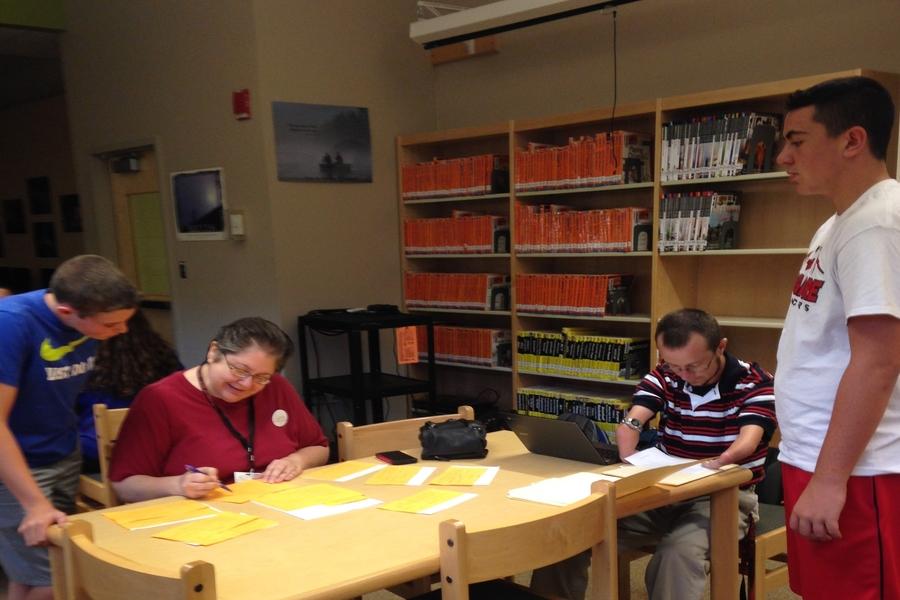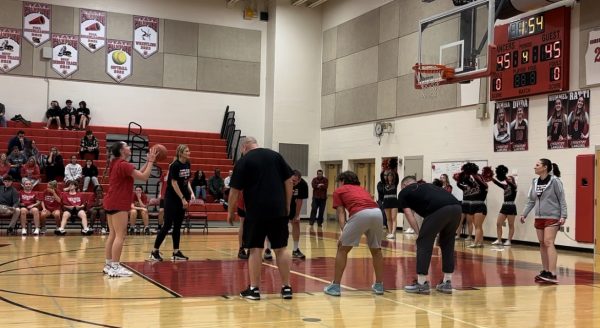Latin 1 vs. Spanish 3: Classes battle for language title
Teachers Mrs. Carter and Mr. Snow are checking students Joel Tate, left and Jake Booth, right.
September 11, 2014
Latin is battling Spanish for the title: World’s Greatest Language.
Mrs. Deborah Carter, Latin 1 teacher, said, “Total World Domination.” That’s what she hopes to accomplish.
The Latin 1 and Spanish 3 classes compete in a vocabulary, grammar and history challenges every Friday for the next four weeks. They meet in the media center during first period. In the first battle on August 29th, Latin won with a final score of first place (997) and Spanish was 2nd (901).
One week later in the second battle, Spanish won with the score of 988 and Latin came in second with 927. So far, the two foreign languages are tied. Nobody can claim the title of “World’s Greatest Language” yet because the next battle can change the whole game.
The battles are taking place to encourage students to use what they have learned in class and view the language from a different perspective. It is a way to make class fun and interesting.
“I’m hoping for Rome to lose the war and for us to rewrite history! I’m aiming for students to learn in a way that provides them a positive experience and gives incentives to achieve beyond a letter grade,” said Spanish 3 teacher Mr. Jake Snow.
Students practice all week. Every week, the two classes receive challenges to prepare them for the “real deal.” The students have four days to learn vocabulary, grammar, and history of their languages. While it may seem easy, the preasure of juggling three classes make out for hard work.
Latin 1 student Erin Lafferty said, “The students have four days learn the vocabulary, grammar or history of their languages. It seems easy but it is not. If you spend at least 15 minutes of studying at a time, you are prepared and fine. Plus you have the other members of your centuria to help if you don’t understand.”
The teachers have come up with a score sheet: Level 1 begins with easy questions, and Level 4 is more difficult. As each level increases in difficulty, the score also increases. Each group has to get at least 80% of the questions correct or they can’t move on. When all the groups in each class have completed the challenge, the teachers calculates the groups’ scores. After the final round, all four numbers are added up and averaged to get the total, since the Latin 1 class has far more students than the Spanish 3 class.
Mrs. Carter said, “We wanted it to be as uncomplicated as possible because there’s a reason neither one of us teaches math.”
Some say it’s fun, while others find the contest to be hard work. It all depends on how well each student studies and pays attention.
“I like the battles. It’s a different way of learning,” said Spanish 3 student Sophia Heitzig.
Mr. Snow was the one who came up with the challenge. “I started to ask Mrs. Carter questions about Roman warfare,” Snow said. “Afterwards, I joked that she taught such a violent subject. I wouldn’t be surprised if her classes invaded other classes.”
“ Some of us foreign language teachers were at a workshop, and Mr. Snow thought of the general concept. Between the two of us we figured out the details, naming battles after actual battles in the Cantabrian Wars,” added Carter.
Sophomore Erin Lafferty said, “ I think other teachers should do battles. I think it would help us remember information and practice using it in a fun way. If teachers did these battles, they could add their own spin off of it that incorporate their subject. Students could really benefit from this.”
Why Spain and Italy?
Carter said, “Obviously, we are sworn enemies. Seriously. . . it’s partly because Mr. Snow is an innovative teacher who is willing to try anything that might help students learn. But we’re not stopping after this war, you know.” She added, parenthetically, “That’s right, Ms. Newcomb – you’d better watch out because we’re coming for Britannia next!”
There are many benefits of each language. People who study a foreign language are able to understand different newspapers, books, movies, and, most importantly, people.
According to Washington State University, research has shown that math and verbal SAT scores climb higher with each additional year of foreign language study.
Sophia Heitzig said, “Spanish is a widely used in the U.S. Many many foreign countries speak Spanish. It is probably the most useful language besides English in the US.”













